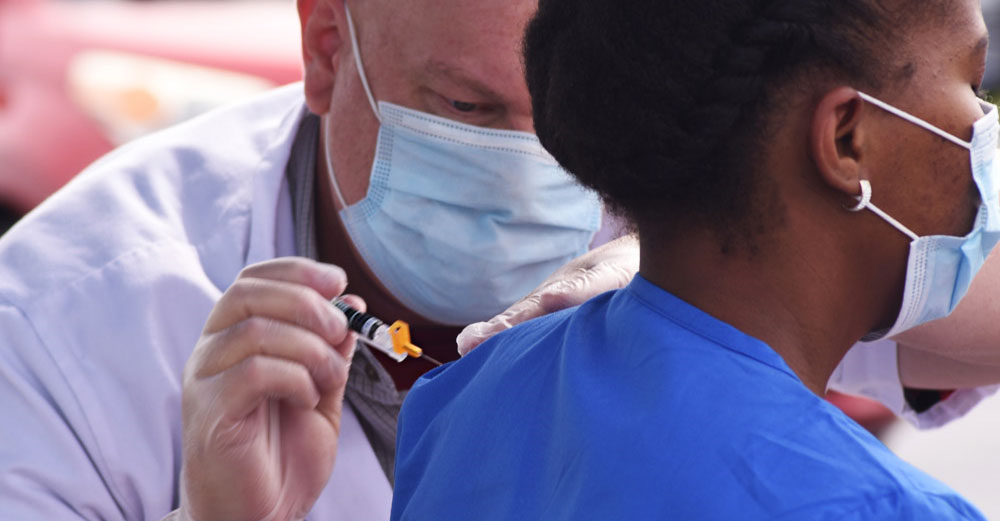
For years, the Centers for Disease Control and Prevention has advised anyone over six months of age to get a flu vaccine. This year, those words take on greater importance as we continue to combat the COVID-19 pandemic amid the upcoming flu season.
Across the SUNY system, campuses are working hard to get students to line up for flu shots. Many are using social media campaigns, direct email messages and campus flyers to spread the word. They’re also forging partnerships with drugstores/pharmacies and supermarkets to host flu clinics on campus in order to provide access to all students. Here’s why a flu shot matters more than ever:
The flu is a serious, potentially fatal disease.
These days, COVID-19 gets all the attention, but influenza remains a serious and potentially fatal disease, especially in people with compromised health and those who are elderly.
“We never really want to get the flu,” says Thomas A. Russo, MD, chief of the Division of Infectious Diseases at the Jacobs School of Medicine and Biomedical Sciences at the University at Buffalo. “It’s a very dangerous disease, especially if you have underlying heart and lung disease and are older. Those conditions are associated with significant mortality.”
According to the Centers for Disease Control and Prevention, influenza sickened 35.5 million people in the U.S. during the 2018-19 flu season, and caused 16.5 million medical visits, 490,600 hospitalizations and 34,200 deaths.
While the efficacy of the flu vaccine varies every year, it does decrease the chances of getting sick and rates of hospitalization and death. The CDC estimates that in 2018-19 flu season, with 49 percent of the U.S. population getting the flu vaccine, we were able to avert 4.4 million illnesses, 58,000 hospitalizations and 3,500 deaths. Getting the vaccine can also reduce the severity of symptoms, if you do get sick.
We don’t know what will happen if you get both COVID-19 and the flu
The flu season was nearing its end when COVID-19 began to spread across the country last March. As a result, we have no experience with what happens in patients who contract both diseases. “We don’t really know what the impact will be if someone gets both influenza and COVID, but we think it will be more lethal than either one alone,” Russo says. “We’re afraid that there will be a synergistic effect, where the combined effect of both diseases will be greater than just the two added together.”
The flu and COVID-19 look alike
To make matters more challenging, both diseases are primarily respiratory illnesses. Both can cause fever, cough, shortness of breath, fatigue, and sore throat. Both can also cause body aches and muscle pain. And while the loss of taste and smell is more often associated with COVID-19, it is possible to lose those senses when you have the flu, too.
With signs and symptoms so similar, it will be difficult to determine what you have if you do get sick. Those symptoms are also seen in bronchitis, sinusitis, or the common cold. The only way to know for sure is to get tested, which leads to the next challenge.
A severe outbreak of the flu, on top of a surge in COVID-19, will strain our healthcare resources
A big worry in the COVID pandemic has been the burden on our healthcare system. Because it isn’t easy to distinguish the flu from COVID-19, patients who come down with symptoms are likely to need testing for both diseases. If severe enough, both may require a visit to a doctor’s office or a hospital. If tests are in high demand, and health care facilities fill up with flu patients, it will take away precious healthcare resources from patients with COVID, the more serious disease. “If we can’t keep flu cases down, it strains testing, hospital beds, and intensive care unit capacity,” Russo says.
The good news is, cases of the flu in the southern hemisphere – countries like Australia, Chile and Brazil – have had fewer cases of the flu this year, thanks largely to public health measures such as masks and social distancing, experts say. However, it’s no guarantee that the U.S. will have a similar experience.
The bottom line, Russo says, is to get a flu shot this year. “Since there’s no vaccine for COVID, we want to minimize the flu,” he says. “And we want to continue masking, social distancing, and hand hygiene.”




